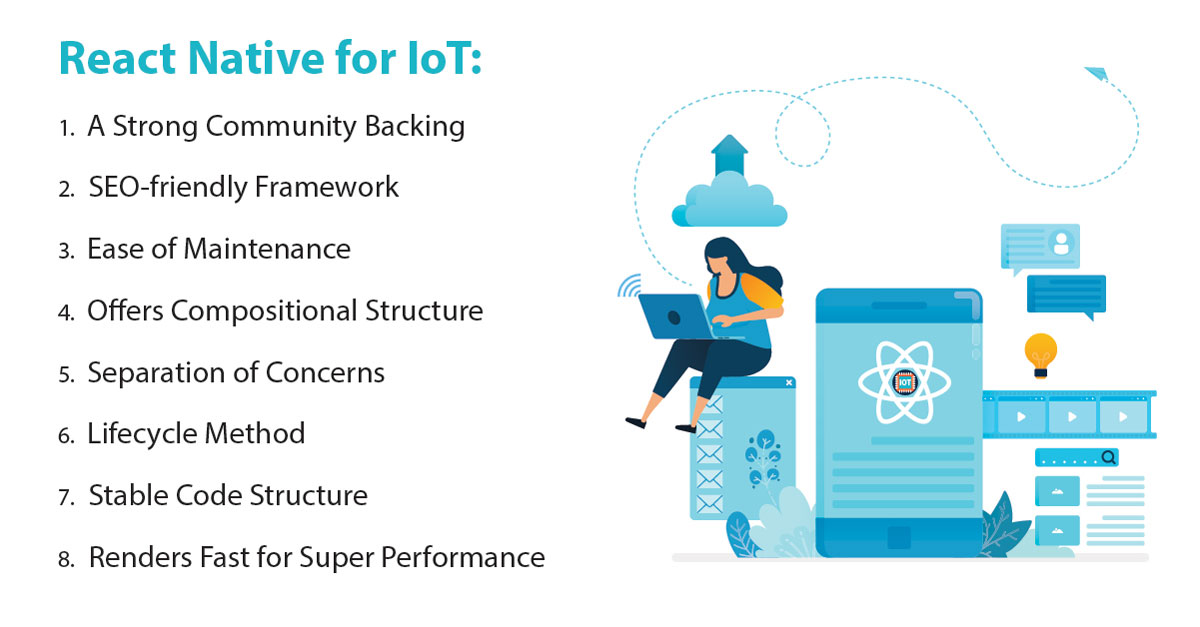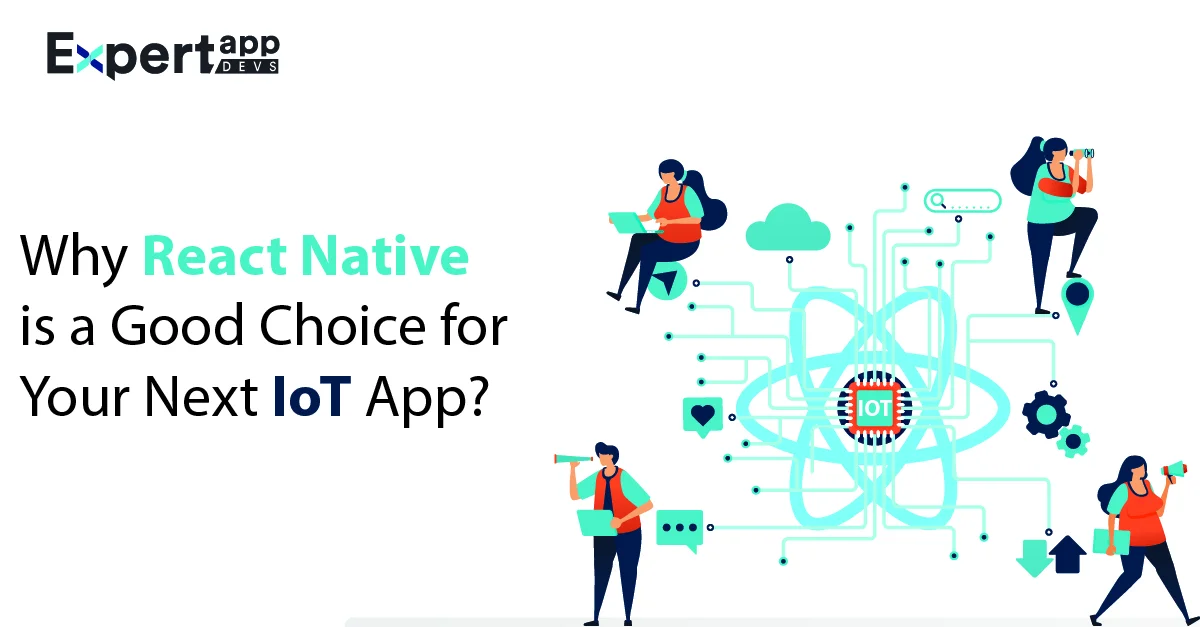How React Native Can Help Deliver Capable IoT App Solutions?
Internet of Things combined with Cloud Computing is reigning the technology trends. Businesses are creating, rather innovating, with IoT to produce exceptional solutions that can enrich lives and offer convenience.
IoT solutions help and assist people; some solutions help businesses make decisions. Every IoT app results from the target market's needs and the brilliance of the app owner who came up with the idea.
However, the one thing that most owners are continuously thinking about, post validating their idea, is the development approach. Given the vast target market and the extensive usage of iOS and Android, developing for a single platform first may not deliver the appropriate results.
Leaning Towards React Native
As a result, most of you may use cross-platform solutions to develop IoT apps. The most important question is whether to use Flutter or React Native for development.
Developers are caught favouring React Native and Flutter to deliver capable app solutions. However, while Flutter is gaining the upper hand over React Native for any app solutions, React Native is giving fierce competition.
The loyalists of React Native understand the app can offer highly native-like solutions that make these solutions functional, reliable, and enriching. In addition, the platform itself, with the support of a strong community, is evolving by implementing new plugins, standards, and components for ease of development.
Popular apps such as Walmart, Facebook, Facebook Ads, and Airbnb were developed using this framework.
Top reasons developers love this platform:
- You don't need to learn a new programming language to develop apps with React Native; you can code using JavaScript, C++, C#, and some of the other commonly used languages
- It has complete support from Facebook in terms of updates, initiatives, and the React engine
- There are a lot of experienced developers for React Native, which makes finding and hiring the right person for the development easy
- Fast refresh is a feature that offers immediate feedback on the updates you have incorporated into your mobile app
- You can develop a single codebase and use it for different platforms
We have seen in detail how developers prefer React Native. However, before we dive into the React Native for IoT part, let's understand the current IoT scenario.
The World of the Internet of Things
The advances in the Internet world, thanks to the brilliance of software developers, can be observed through the Internet of Things. For the uninitiated, it is the technology that ensures that things (hardware) are connected over the Internet.
For example, you have your entire home security system connected to the phone via a mobile app over the Internet. So, whenever you are online, you can check on security.
The few things that have accelerated the IoT is the need to stay connected with your home and office. As a result, home automation has been one of the most significant advancements.
A lot of industrial equipment has become smart with the adoption of IoT. For example, you know it is time to maintain your intelligent filter because it is connected to the phone via the Internet.
Internet of Things is not a technology trend that will fade away with time; it will enjoy a great future as the technology is all set to enter industrial automation. Integrated with cloud computing and Artificial Intelligence, this technology will help automate several business processes and enhance the customer experiences.
At the core of these processes are data and a lot of devices. Connecting them will help access the raw data that can enable actionable insights leading to better decision making.
Why React Native for IoT Projects?
When you build IoT projects, you want to ensure it reaches both iOS and Android markets simultaneously. It gives you a glimpse into the acceptance of your product and lets you know who belongs to your target market.
Many developers feel React Native is a promising framework for developing your IoT-driven application. Let's go through the advantages of building a React Native IoT app for your business.

#1. A Strong Community Backing
This is one of the most significant advantages of developing a project in IoT. During the development phase, there will be several places where you might not realize how to proceed with the coding. In addition, you might have issues with the framework if you are new to development.
At all these points, you can reach out to the community. For example, there would be developers who have solved similar problems and can offer you suitable solutions. Similarly, you might find people who can work with you on this project.
These developers can offer components and improve your app to clean your code and ease your difficulties.
#2. SEO-friendly Framework
Why is this an advantage for the developer building IoT solutions?
When your site is search engine friendly, it enhances your visibility, maximizes your ranking, and gets more visitors. Eventually, you can boost your conversions.
When you work with React Native, it offers high-performance solutions with excellent speed. In addition, react is known to provide superior user experiences through its design and clean code strategies. As a result, it wins over the search engine that lets these websites rank higher.
#3. Ease of Maintenance
One of the biggest headaches you are likely to face, especially when working with numerous devices and a software solution is a maintenance. But, with React Native, you don't need to worry about maintenance. These app solutions are easy-to-maintain and come with scalability.
The coding structure, the overall design framework, and other details about React reduce the hassle around the app development. You can easily add new code, change the existing code or update the app at your convenience.
#4. Offers Compositional Structure
React Native has a compositional structure, making coding easy and experiential designs. You can reuse the components and codes at different places throughout the app development. This, in turn, offers a more organized structure throughout the code.
Eventually, when it comes to code handling, owing to similar classes and a lot of comments, the developers can handle large coding structures and complex apps.
This is one of the reasons why you should use React Native for IoT. The IoT apps are complex and contain several devices and points. Therefore, to ensure smooth development, the compositional structure of React will play a pivotal role.
#5. Separation of Concerns
When you are developing an app, there are objects, components, classes, and several layers. Every element or object may be different and needs to be coded accordingly. For instance, the AC could have several components, and each one needs to be automated for the proper functioning of the automation.
Separation of concerns ensures that there is proper segregation of the components. It also ensures that the data passing occurs through objects that contain information about these components.
You can separate the child and parent components from each other. For example, in an IoT app that is component-based, you can use React Native as the framework.
#6. Lifecycle Method
The components in an application will undergo several changes at different times within the app. Therefore, there will be several app interactions, and every single change should occur without any friction. To manage these changes, you will need to use the lifecycle method within React. It will ensure that the interactions occur in real-time and the changes are initiated smoothly.
Let's take the example of IoT to understand this. When you interact with the mobile app to switch on your smartphone, this is one change. Next, you are asking the light to switch on. Now, the next chance would be when you want to go for a different light. Lastly, you may want to switch off the light.
These changes are all interactions that the device has with the mobile app over the Internet. Therefore, each shift should occur without disturbance stably.
Using three different methods, the life cycle is initiated to improve experiences.
1. Initialization for mounting: You should define the initial state for all the components within the application. you should also set the props.
2. Updation for providing updates: The component will be rendered and updated during this stage. It will first be mounted post initialization.
3. Destruction for unmounting: The instruction is given for unmounting, and the particular component will return to the initial state.
#7. Stable Code Structure
When developing a code for the Internet of Things, you are working around devices. Therefore, it is essential to connect things over the Internet with the mobile app such that whenever initialization occurs, it interacts seamlessly.
Coding plays a pivotal role in this structure. Your code should be stable, organized, and clean. This is so that whenever you need to make changes, it is possible to identify the right places and improve your execution.
#8. Renders Fast for Super Performance
When you develop an application, you want to ensure that the code renders fast so that the application is launched within seconds. This ensures that the users don't move out of the application.
The virtual DOM in React Native, something that Facebook introduced with the platform, makes the execution of the code easy and fast. In addition, it removes the rendering obstacles that can hinder the speed or the performance.
It would help if you had something this fast and functional for your IoT applications to convert the interactions into data within seconds. It will help engage better and improve the retention rate as you are offering exceptional experiences.
Making your First App with React Native
For this example, we will use Bluetooth Low Energy-enabled devices for communication over the Internet. We will jot down the steps here to help understand what it takes to develop a React IoT application.
- The connected device will have different characteristics that you will be reading via the Internet. For example, if you focus on measuring a particular place's temperature via the device, temperature becomes the characteristic. This will play a pivotal role in devising the application.
- You need to read the characteristic. In the above example, the device is used to measure temperature and is read over BLE.
- You will first connect the application via the BLE to the device. There is a unique ID that you need to mention in your application. You will need to read the Service UUID
- From that, you will need to read the characteristics present in the services for the BLE. Depending on the characteristic you are interested in, you will pull that one
- Add a descriptor for the characteristic. This will ensure that the app understands the need for the particular descriptor
- Connect the object to the React Native application. We have already done step two. In this, we will use the Arduino circuit to read the application. You will need to Arduino Uno board, a BLE module, wires, and resistors to make the circuit. Once the circuit is complete, you can use the React Native application to read using step #2.
- Make sure to complete the testing of the circuit and the complete application. It is essential that the application can pull the suitable characteristics.
Conclusion
React Native enhances developer productivity, issues better ways to connect with the devices, and helps improve the Internet of Things applications. Stable codes, clean structure, separation of concerns, and lifecycle method ensure no frictions in the interactions.
You can develop your application using Bluetooth Classic, BLE, or WiFi. The idea is to use the apt model that fits your sensor requirements.
Make sure to study the sensor you would be using before defining the code structure. Lastly, you should determine the business logic first and make a list of components and characteristics to make it easy to develop your code.
 Jignen Pandya
Jignen Pandya





